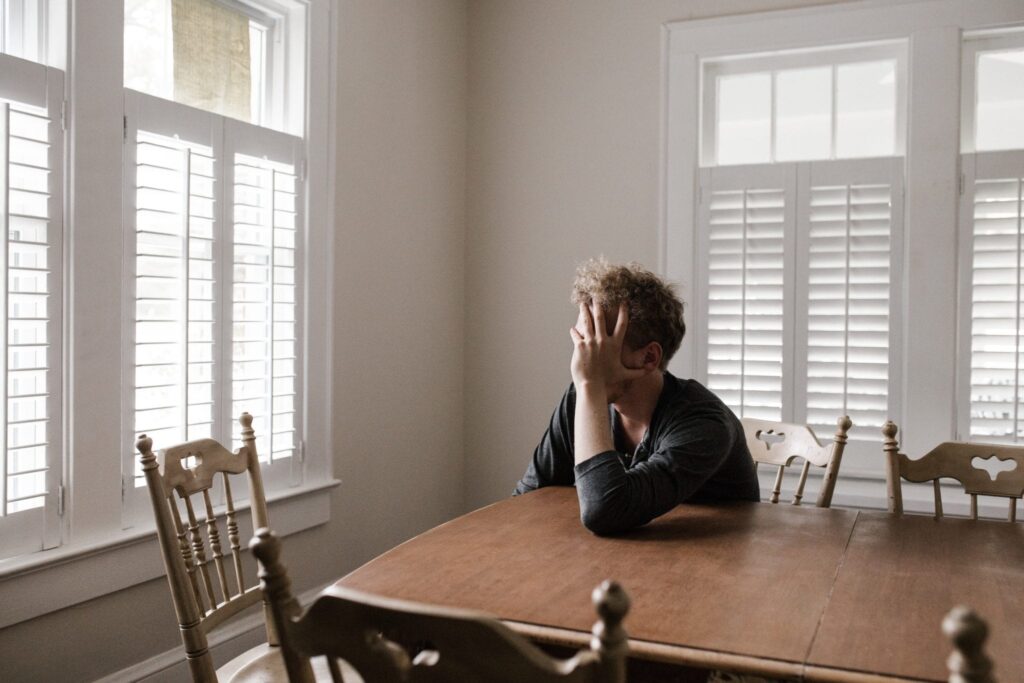Anxiety arises for almost all sentient beings in certain situations. And there are times when worry can be useful or productive. A little stress can make us sharper, or enhance our performance at times. Yet humans, and particularly modern humans, now often seem to experience constant or chronic low-level anxiety. Anxiety disorders are the most commonly diagnosed mental disorders in the United States.
Physical Signs of Anxiety

Anxiety manifests in many ways, but we generally can observe the physical signs as our body goes on high alert. Our breathing may become shallower and move higher in the chest. Our palms or other body parts may sweat. Some of us feel a tightness in the chest or the throat that may be accompanied by digestive disturbances. We may not be able to concentrate or may feel weak and trembly. Sleep can either become difficult, and disturbed–or we may shut down and do nothing but sleep. Our worries may seem to pile on top of each other so that we feel like our mind is spinning out of control.

If you’ve never experienced a panic attack, I can tell you–it’s a frightening and overwhelming feeling. When I’ve had high-level anxiety in the past, I often felt frozen in place. Making any decision or movement seemed insurmountable. But by adopting some strategies from basic Buddhist teachings, it has been years since that terrible paralysis struck.
Anxiety: 20 Gentle Techniques for Transforming the Worry
When worry, anxiety, or fear hijacks our minds and behavior, what can we do?
- Acknowledge the anxiety. Don’t try to push it away or pretend it’s not happening. It is, but that’s okay.
- Say to yourself, “I’m having an anxious thought.” Do this gently and with humor.
- Once you’ve acknowledged the thought, don’t follow any storyline. Recognize that an anxious thought is simply a thought. It is no different than the thought, “The sky is blue.”
 Say to yourself, “This fearful or worrying thought will disappear. It is not solid.” And then notice when another thought pops into your head almost immediately. Repeat this process until you see this pattern of arising, remaining, and disappearing. Once you watch this pattern dispassionately, you can understand that thoughts have no real essence. You don’t need to buy into the spinning.
Say to yourself, “This fearful or worrying thought will disappear. It is not solid.” And then notice when another thought pops into your head almost immediately. Repeat this process until you see this pattern of arising, remaining, and disappearing. Once you watch this pattern dispassionately, you can understand that thoughts have no real essence. You don’t need to buy into the spinning.- Set the deliberate intention that you will not follow the spin of such thoughts. Kindly, but firmly say, “I had an anxious thought. But now I’m going to let that dissolve and know that I am not my anxiety. I don’t need to buy into the story.”
- Realize that anxiety has become a habit. But like any habit, we can choose to change it. It can help to remind yourself that you have a habit, but you are not that habit. You are not “anxiety” or “worry.” Habits take time to change–so don’t be judgmental or harsh if you find yourself slipping into the spin of thinking. But you can catch yourself by saying, “I’m bored or tired of this habit. It hasn’t served me well so it’s time for a change!” Then set your intention again to release anxious thoughts as soon as they appear.
- Take at least three deep, diaphragmatic breaths. As you do this, slow your breathing deliberately and try to extend the exhalation. Think to yourself that you are letting go of the anxious thought–releasing it from your body. Sometimes it helps to imagine the thought as black smoke that you exhale forcefully. Repeat this breathing exercise throughout the day whenever anxiety or worry starts anew.
- If you have a specific problem that is causing anxiety, try to approach the problem as a neutral observer. Instead of thinking about “my problem” can you examine this from another’s perspective? Once you’ve removed the self-centeredness, can you see possible solutions to the problem? If someone else was in the same situation, what could you suggest? If you can think of a solution–even if it is unpleasant–then perhaps it is worth trying that approach.
- On the other hand, sometimes we can’t fix or change things. There may be problems that are not in your control at all. In that case, acknowledge that worrying or being anxious is not bringing any benefit. This takes quite a bit of practice, but if you repeatedly remind yourself of this reality, it can loosen the anxiety. We can practice acceptance of situations that are beyond our control. Anxiety doesn’t give us any power after all, does it?
 Spend time in nature. If you can’t immediately go outside, then stand at a window and look at the sky, or a tree, or a water source.
Spend time in nature. If you can’t immediately go outside, then stand at a window and look at the sky, or a tree, or a water source.- Eat healthy food. Often when we are anxious, we don’t pay attention to good nutrition. But when our minds are out of balance, caring for our bodies can help get us back on track. Avoid sugars that create false highs and spikes. Don’t skip meals or rely on junk food when you start to feel down. Take the time to care for your physical body.
- Avoid caffeine when agitated–or any other stimulants. This is also not the time to indulge in alcohol or drugs looking to take the edge off. Drink plenty of water and choose soothing teas.
- Get moving! If you can, take a moderately paced walk. Or engage in some other pleasurable physical activity for 30 minutes. Focus your attention on your body’s movements. If anxious thoughts arise, remind yourself they are just thoughts. Return your attention to the feeling of your body moving through space. Feel the sensation of your feet pressing on the ground (or moving through water) and try to inhabit your body with greater awareness.
- Talk with a friend or family member–in person if possible. The act of engaging in meaningful conversation with a close individual can allow you to move beyond your worry. Ask questions–what is going on in that person’s life? The act of thinking about, caring for, or engaging with another person in a genuine way can show you that anxiety is not quicksand that is pulling you down.
- Practice loving-kindness or compassion meditations. Skillfully turning your attention outward toward others reduces your pattern of hanging on to stories about yourself. You may want to visit our archives for teachings on Training in Kindness or learn how to practice giving and taking in our Beginner Tonglen practice.
- Wind down before bedtime and allow time for restorative healing. Anxiety or worry often increases at night as we lie in bed making lists or feeling bad. Take the time to prepare for a good night’s sleep by turning off all devices at least 30 minutes-1 hour before you go to bed.
 Take a warm bath, or drink a cup of herbal tea or warm milk. Keep your bedroom dark and slightly cool if possible.
Take a warm bath, or drink a cup of herbal tea or warm milk. Keep your bedroom dark and slightly cool if possible.- Set a positive intention before you lie down. Think to yourself as you prepare for sleep that tonight you will simply let go of any and all thoughts and relax. Imagine yourself sleeping through the night without anxiety. Extend wishes for happiness and benefit to all other sentient beings as you turn off the lights.
- When you wake in the morning, before you get out of bed set another firm intention. Think to yourself that today you are going to recognize thoughts and not follow after them. Resolve to be kind and compassionate to yourself and others throughout your day.
- Do a few minutes of deep breathing when you arise. With your intention already formed, breathe mindfully and think how fortunate you are to be alive and awake today. You now have another day to practice cultivating new habits!
Note: This advice is not meant to take the place of mental health professional guidance. Mental conditions are complex and people differ widely in their conditions and responses. If you suffer from serious anxiety or depression, we suggest that you seek the services of a trained mental health professional.
Hilary Herdman
Samye Instructor










Responses